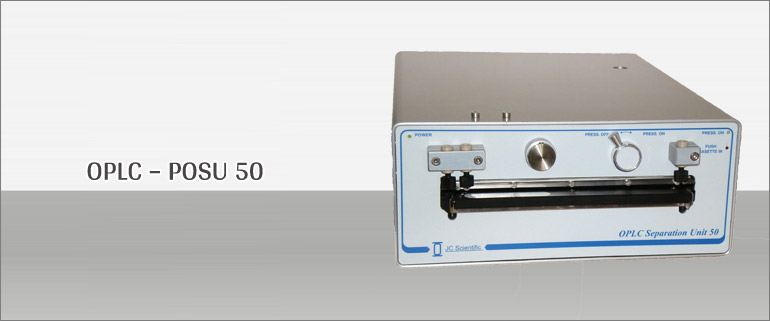Features and Benefits :
Typical Applications:OPLC is a general separation technique that has been successfully applied to areas such as:
QC and In Process Control of pharmaceutical products.
Natural Products: Chromatography Finger Printing, Bio-Assay Guided screening and isolation of active compounds from natural products.
Drug metabolism: Isolation of metabolites in biological fluids.
Purification of reaction mixtures: Isolate compounds of interest for additional studies (e.g. for NMR or MS).
Toxicology: Determination of toxins in foodstuffs (e.g. aflatoxins in wheat)
Technical Specifications:
| Principle of Operation | Over pressured-Layer Chromatography or OPLC |
| Sorbent Bed Compatibility | OPLC layers compatible with OPLC separation unit include: 0.2 mm thick, 5 cm x 20 cm and 20 cm x 20 cm aluminium backed layers, 0.2 mm, 0.5mm thick 20×20 cm glass backed layers. |
| Pressurization | The OPLC layers are pressurized to 5 MPa (50 bars/725 psi) via an on-board hydraulic system using a water/glycerol mixture. Time to reach maximum pressure : less than 1 min Max. Elution Pressure: 4 MPa (40 bar or 580psi) |
| Semi- preparative Scale Operation | Capable of semi-preparative separation with on-line fraction collection. Maximum loading capacity depends on sample and OPLC layer dimensions. 0.5mm thick 20x20cm glass backed Si OPLC layers are available. |
| Mode of Separation | Uni-directional, bi-directional, one dimensional and two dimensional separation can be performed. |
| Solvent Delivery | Solvent can be delivered by any analytical HPLC pump/systems in on-line OPLC system FEW version. For off-line sample application, require pump or software with flow programming capability for solvent linearization. Upper back pressure limit on the pump should be set to 4 MPa or 40 bar (580 psi). |
| Sample Application | Direct Sample Application Mode -samples can be spotted or streaked on the sorbent bed in an off-line mode either manually or automatically using an automatic sample applicator (not included). Multiple samples should be placed on the sorbent bed in a linear arrangement. On-line Sample Application Mode – samples can be injected into the stream of solvent flowing through OPLC using an optional/existing manual injection valve or autosampler. |
| On-line Detection | The POSU 50 can be interfaced to all detectors in HPLC systems (e.g. UV, Fluorescence, Radiometric, Evaporative Light Scattering, MS, NMR). |
| Off-line Detection | The OPLC layers can be readily taken out from the OPLC separation unit and can be examined at any point during a separation. Observation of bands can be performed using UV lamp, densitometer, photographic equipment before or after derivatization with a spray/dip reagent. |
| Safety | The hydraulic system will not function unless a layer holder (cassette) is properly inserted into the separation chamber. There is an indication that the unit is pressurized and ready for use. |


